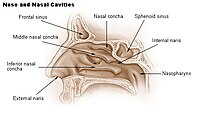
Photo from wikipedia
Abstract Biological rhythms mediate important within‐host processes such as metabolism, immunity, and behavior which are often linked to combating disease exposure. For many hosts, exposure to pathogens occurs while feeding.… Click to show full abstract
Abstract Biological rhythms mediate important within‐host processes such as metabolism, immunity, and behavior which are often linked to combating disease exposure. For many hosts, exposure to pathogens occurs while feeding. However, the link between feeding rhythms and infection risk is unclear because feeding behavior is tightly coupled with immune and metabolic processes which may decrease susceptibility to infection. Here, we use the Daphnia dentifera–Metschnikowia bicuspidata host–pathogen system to determine how rhythms in feeding rate and immune function mediate infection risk. The host is known to have a nocturnal circadian rhythm in feeding rate, yet we found that they do not exhibit a circadian rhythm in phenoloxidase activity. We found that the time of day when individuals are exposed to pathogens affects the probability of infection with higher infection prevalence at night, indicating that infection risk is driven by a host's circadian rhythm in feeding behavior. These results suggest that the natural circadian rhythm of the host should be considered when addressing epidemiological dynamics.
Journal Title: Ecology and Evolution
Year Published: 2022
Link to full text (if available)
Share on Social Media: Sign Up to like & get
recommendations!